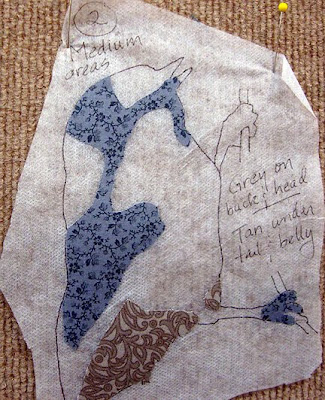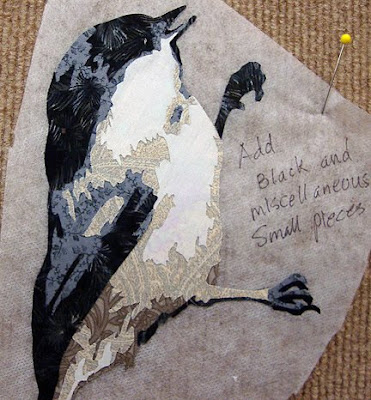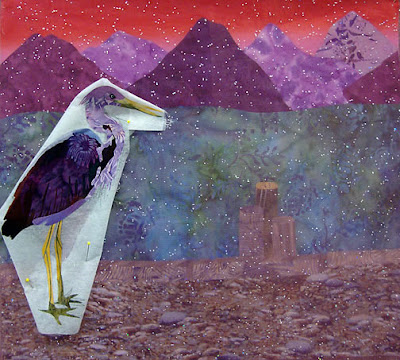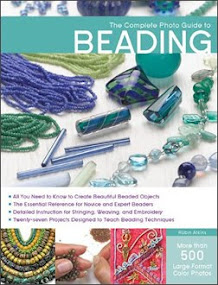
When I saw the above wall hanging by Karin Franzen at the La Conner Quilt and Textile Museum, I nearly swooned! My reaction was partly because of the subject matter, fire weed and cranes, so realistically, yet so compellingly portrayed and partly because the transparent quality of the layers of silk organza used in her hangings gives a sense of ephemeral spirituality to her work.
It's a whole day trip at a cost of about $100 to go to the Museum from our island, yet I managed to go three times to see Karin's work during her exhibition there. No wonder, when she emailed that she was teaching a three-day workshop, I HAD to do it. What follows is a little about her techniques and a little about my experiences in the workshop.
Above is one of her current pieces. Her work has evolved, as you can see if you take a good look at her gallery (here), from being quilts (layers stitched together) with borders to her current pieces which are layers of hand-dyed silk organza joined at the top with the subject and background sewn partly on the front and partly on the back sides of the organza... no batting, no borders, no quilting...
Here she has flipped up the top (subject) layer of the piece to reveal one of the hand-dyed layers of silk organza.
Here you can see the same piece back-lit by sunlight. Her pieces change entirely depending on the lighting. Wouldn't this be lovely hung as a room divider where it would get front-lit part of the day, back-lit the rest of the day and entirely different lighting at night?
While we're on the subject of this piece, above you can see a detail of the egret, the many little pieces of fabric that she uses to reveal her subject and the stitches that further bring out the details.
And here is the eye. Sometimes Karin uses fabric paints or dyes to create detail, texture, or alter the color of her fabrics. In this case, I think she may have painted the egret's eye.
Below are some pictures showing the steps Karin takes in developing her subjects.
She starts with a good-quality print of a picture, most often one she has taken, of her subject bird or flower. She then takes the image in Photoshop Elements and applies a filter called poster edges to the image. Then using a sheet of transparent acetate, she traces around the edges to create a cutting pattern. In the picture below, she has outlined the edges right on the image, but that's not how we did it in class.
The next step is to reproduce the acetate tracing on plain paper using a copy machine to get the desired size. This will become the cutting pattern for the fabrics.
Karin's method for creating the subject is to fuse bits of fabric to a very thin piece of non-fusible interfacing. She uses Pellon 805 Wonder Under (nothing else will do!) to fuse fabric to the interfacing. Below you can see the bird outline traced from the cutting pattern onto non-fusible interfacing. Now we're ready to begin fusing!
Starting with the medium value colors, select appropriate fabric. Take a small piece of Wonder Under and place it paper side down over the subject cutting pattern. Use a fine point marker to trace the shape on the glue side of the fusible. Cut around the shape, leaving a 1/4" edge. Iron to wrong side of fabric. When cool, peel off the paper backing. You will be able to see the traced outline on the glue side. Cut out the shape. Place your non-fusible tracing over the cutting pattern and align the cut piece. Iron to fuse it to the interfacing.
Following the same steps, trace, fuse, cut and fuse the fabrics of lighter value next.
Next do the dark fabrics. I didn't say this above, because there was already a lot of information, but the first fabrics applied, generally the medium value fabrics, should be cut about 1/8" larger than the actual area. These pieces will be overlapped by the more precisely cut darker or lighter fabrics in the next steps. Below the little chickadee is now recognizable.
Last, cut and fuse the small detail pieces to complete the subject.
When all the details are in place, the next step is to stitch around all the fabrics using a free-motion foot on your sewing machine. The stitching is used to keep all the bits of fabric in place and to enhance the detail. You can see this stitching in the picture above of the egret's eye.
After the stitching is complete, Karin cuts around the outside edge of the subject, cutting away all of the interfacing that isn't covered with fabric and stitching.
She then places her subject on a piece of silk organza and stitches it in place. Finally, she hand-dyes other layers of organza, fusing background fabric pieces directly to the organza and hand stitching on them to enhance design elements, and combines layers with her subject layer to achieve the look she wants. She then stitches the layers across the top and mounts them on a hanging rod.
Obviously, I've simplified her methods greatly here, as I do not intend this as any kind of tutorial. Indeed, in three long days of class, we only touched the surface of how she creates her pieces.
The first day of class we did some sketching and used our sketch to create a background for our subjects. Her suggestion was that we sketch a dream, a childhood memory, or a childhood fantasy. And then, using the same methods outlined above, cutting and fusing fabrics to an interface backing, we were to make a piece from the sketch. Below you can see mine, from a sketch of a childhood fantasy about being a ballet dancer.
Here it is again showing a layer of dyed organza over the background and the picture of a northern flicker, which is my chosen subject for my class piece.
Not having a good idea of the whole when I started, my background did not seem to relate very well with my subject.
The second day, we spent a lot of time evaluating the backgrounds we had made, trying to find a way to make them work with our subject, deciding on which organza to use and how big to make our subject. At the end of day two and for all of day three, we worked on our subjects. I learned several things right away:
- It's so easy to iron the wrong side of fusible, making a terrible mess on the iron.
- It's so easy to trace on the wrong side of the fusible, making a mirror image piece.
- It's so easy to iron the fusible to the right side of the fabric, making a mirror image piece.
- Cutting out intricate little pieces is not very easy.
- Knowing which piece to cut bigger so they can be overlapped later isn't easy.
- Keeping track of which pieces you've already applied isn't easy.
- It takes concentration, concentration, concentration to get it right, and at the same time, it's a bit like paint-by-number, something I never enjoyed much.
Perhaps this type of work is all about me deriving great pleasure from looking at Karin's pieces and not at all about me doing it. At the end of a whole day, I didn't have much to show for my efforts. Below you can see that my flicker still needs spots, two feet, a wing, a tail and lots of TLC stitching.
My plan is to make the background a separate piece, to make the subject for it a rabbit which will be placed on the organza so that it covers the white bunny on the background and be much more realistic. The white bunny will be its spirit or totem energy.
For the flicker, I plan to make a new background of madrona trees in berry phase. The flickers come to our property every year to feed on the abundant madrona berries. The subject layer will include a madrona branch, some leaves and berries as well as the bird.
We'll have to see if I actually do these two pieces. For me they are character building. Also, if you know my work, you know that it's quite abstract. Even the few somewhat representational pieces I've done are not very realistic. I'm fairly certain that my primary role here is to be a huge fan of Karin's, to swoon at each new piece...
In case you're still interested, I thought I'd end with a few photos of other student's work. (My apologies, I only took my little camera and had to contend with the affects of indoor lighting sources.)
The first photo is Lunnette Higdon-Hertel's swan. She's the only one in class to finish fusing her subject. Like mine, her background story didn't quite match her subject. In the background review, it was suggested she turn her background upside down, which is how it's shown below. However, she plans to make a new and more appropriate background.





Useful TIP for Beaders
In order to stabilize the silk organza so that you can sew on it, Karin taught a very useful method using Solvy.
She tore off small pieces (4" x width of roll) of Solvy and one by one dissolved them in about a cup of warm water, stiring all the while. When the mixture was slightly thickened, like pancake syrup, she poured it into a spray bottle. She pinned the organza on a piece of insulation foam covered with plastic and then sprayed it with the Solvy mixture. When it dried (2-3 hours later), the organza was impregnated with Solvy, giving it a stable hand for stitching. After the stitching is complete, she simply puts the piece in a tub of water to rinse the Solvy away.
I believe this method might work well to stabilize cotton or silk fabrics for bead embroidery! I now use acid-free interleaving paper under the fabric as a stabilizer, which works fine. However, I'm going to try the Solvy method as soon as I get off-island to buy some. I'll let you know!
















Piękne ptaki i wykonanie.
ReplyDeleteI really like how your Flicker is coming, even though not finished yet. I've tried some artforms that I really liked the look of but found they were just not what I enjoyed doing. I learned a lot in trying them out, but I haven't gone back to do anything more with them.
ReplyDeleteThat idea of using a Solvy spray for stabilization seems interesting. I like using paper or stiff stuff, but there are some fabrics that would be lovely to work with that just aren't very good with paper.
What a fascinating workshop - all of the pieces are swoon worthy - absolutely stunning.
ReplyDeleteFabulous post! You're so luck to have been able to go to Karen's workshop. The flicker shows a lot of promise and I'm sure the arbutus (madrona) behind it will be equally lovely. Keep on plodding! I would have a hard time with representational as well.
ReplyDeleteThe process involved here is way more than I will ever try to do, but I appreciate it no less! Thank you for sharing so much of it, Karen's work is incredible!
ReplyDeletemesmerized by that eye on the great blue
ReplyDeleteBeautiful work for sure! Your pieces are going to turn out great as well!! Can't wait to see final results. So glad you enjoyed this workshop!!
ReplyDeleteI LOVE your piece without the Flicker. I hope you do something with that part of your project and forget about the stuff that bores you. It sure doesn't need the Flicker to work as a delightful, playful, interesting, joyful piece.
ReplyDeleteThe Flicker looks great but I can see there is a huge amount of fiddly work involved. I hope you do get to finish your piece so we can all see it. Karin's work is amazing.
ReplyDeleteYour flicker is beautiful. We have them in our yard in the winter. I am really amazed at how much you accomplish while I'm plugging along.
ReplyDeleteAnn S
Robin, yes please, let us know how the Solvy works out. Thanks for featuring this artist - beautiful work.
ReplyDeleteThank you for this post. I saw the exhibit at La Conner as well and cannot forget her work! Thanks for sharing your experience with us.
ReplyDelete